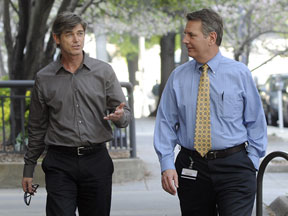The offices of the Provost and the Vice President for Information Technology have created the UAB Center for Teaching and Learning to support excellence in teaching.
 |
| Ronan O’Beirne (left) and Jonathan Waugh will work together to meet the teaching needs of faculty in the new UAB Center for Teaching and Learning. |
The center will promote learning through a commitment to pedagogical best practices, appropriate and effective use of technology and innovative collaboration.
“The mission of the Center for Teaching and Learning is to promote and support excellence and innovation in all aspects of teaching,” says Suzanne Austin, Ph.D., vice provost for student and faculty success. “This will include excellence across formats — including traditional in-class instruction, blended formats and completely online instruction — and across pedagogies.”
“The CTL is something I wanted to start for years —since I served on our last Quality Enhancement Plan committee,” says Doug Rigney, Ph.D., vice president for Information and Technology. “It could not have gotten off the ground without the support and collaboration of Suzanne and the provost’s office.”
Interim Faculty Director Jonathan Waugh, Ph.D., and Instructional Technology Director Ronan O’Beirne are the leaders of the Center for Teaching and Learning. Waugh will assume his role May 1. O’Beirne and his technology team began work in the center this past fall.
“It’s a partnership intended to merge support for pedagogy, design and technology use and provide a full range of faculty-support services,” O’Beirne says. “Technology is becoming more central to education, but it’s not necessarily changing information. Instructors still have to generate content that students want to learn, but technology is becoming a significant part of delivering education.
“Jonathan has been teaching a long time and has a lot of good practice behind him. I’ve taught a lot online and with technology. We’re trying to merge those two functions to enhance teaching and hopefully help create new and effective teaching practices —with or without the use of technology.”
“There will be situations in which I will work with a faculty member who has a particular need in the classroom and it won’t have anything to do with the electronic aspect of teaching,” Waugh says. “But when there is a need to infuse technology or when technology could be part of the solution, Ronan’s team will be there to support that solution.”
In his role overseeing the Teaching Enrichment Program within the School of Health Professions, Waugh worked with first-time faculty, new UAB faculty and faculty veterans.
Waugh says the center will incorporate some of the philosophies of the Harvey Brightman Master Teacher Program and will be a place for individual faculty members to learn, interact and experiment with others. They will be able to try new methods in the teaching laboratory — even in front of sample groups of students — and have access to resources that they don’t own or have access to within their school.
“We have two goals, one of which is to help new faculty integrate more quickly and have a much smoother start to their teaching career at UAB,” Waugh says. “We also want to work with seasoned faculty who want to try new things. We want to facilitate that experimentation.
“We want to be a showcase for faculty,” Waugh adds. “If somebody’s got an interesting teaching method, we want to show them to other faculty and let them see what they are able to do.”
O’Beirne’s instructional technology team of designers and technologists provide workshops for groups of faculty and one-on-one consultation on course design and institutionally supported learning technologies.
“My group is going into departments and assessing the hurdles or stumbling blocks in running a course, whether it be presenting content, classroom management or assessment,” O’Beirne says. “We want to know the hurdles faculty are facing and see if we can solve it with technology. If we can’t, we have Jonathan available now to lend his expertise. We have a more integrated approach to solving the problem.”
The Center for Teaching and Learning is aided by a Faculty Advisory Council (FAC), which provides a channel for collaboration, feedback and guidance between academic units and the center.
This includes guidance to Instructional Technology (related to technologies) and to Faculty/Student Success (related to pedagogy and best practices) that could be recommended for campuswide adoption in online and classroom learning environments. Specifically, the FAC will provide such feedback and guidance as it relates to:
- The instructional needs of UAB faculty and students
- Breadth of potential use and adoption by faculty
- Effectiveness (demonstrated through pilot projects, faculty experience, etc.)
- Ongoing support availability both at the school and university levels
- Funding Priority
The council includes one faculty representative from each academic unit (college/school) and a representative from the UAB Faculty Senate. Other approved representatives, including a representative from Instructional Technology and Faculty/Student Success, may attend meetings. The council, which will meet at least quarterly, will be co-chaired by Austin and Rigney. It also may engage representatives from the larger community as needed for more specific or detailed review.
Representatives from the center and the council will work together to review certain technologies and programs that may enhance the campuswide teaching and learning environment. The FAC will review such recommendations or information and assist the CTL in determining the value and priority of adopting the technology or program for the overall learning environment.
Visit www.uab.edu/ctl for more information on the center. Contact O’Beirne at ronan@uab.edu to inquire about technological guidance. Waugh will set office hours soon before his appointment begins May 1. He can be contacted at waughj@uab.edu.
